Raaga Based Song of the Day: Chalo sajana jahan tak ghata chale….
Raag Basant Mukhari, Tal Kaherava
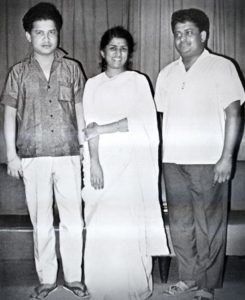 One more song composed in Basant Mukhari. But, once again a reminder that films songs composers are not sticklers to purity of any raaga in their compositions. It is not their aim. Their aim is to come up with tunes for songs that would be popular. As far as popular tunes are concerned, Laxmikant Pyarelal came up with such hit songs in this movie, penned by Majrooh Sultanpuri, that these are still fondly remembered some 50 years after the movie Mere Hamdam Mere Dost was released. This was sung by Lata Mangeshkar. For me, it is indeed a nostalgic song as it was shot in the lawns of Palace Hotel in Chail, on the hill across from my house in Whispering Winds, Kandaghat (Please see: ‘Home Is Where The Heart Is: Kandaghat In Shimla Hills‘).
One more song composed in Basant Mukhari. But, once again a reminder that films songs composers are not sticklers to purity of any raaga in their compositions. It is not their aim. Their aim is to come up with tunes for songs that would be popular. As far as popular tunes are concerned, Laxmikant Pyarelal came up with such hit songs in this movie, penned by Majrooh Sultanpuri, that these are still fondly remembered some 50 years after the movie Mere Hamdam Mere Dost was released. This was sung by Lata Mangeshkar. For me, it is indeed a nostalgic song as it was shot in the lawns of Palace Hotel in Chail, on the hill across from my house in Whispering Winds, Kandaghat (Please see: ‘Home Is Where The Heart Is: Kandaghat In Shimla Hills‘).
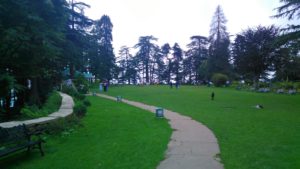
If you recall, on the 50th day, I had given you a song in Basant Mukhari composed by the best music duo ever: Shankar Jaikishan: O basanti pawan paagal (Please see: ‘Raaga Based Song Of The Day #50‘). That time, I missed giving you this; as I said, a song shot on the hill opposite Whispering Winds, Kandaghat. Hence, here I am, again with the same raaga.
We have completed seventy days of Raaga Based Songs of the Day. Our first post in the series was titled ‘Raaga Based Song Of The Day #1’ and the song was a Mohammad Rafi and Lata Mangeshkar song from the 1970 Shakti Samanta movie Pagla Kahin Ka: Tum mujhe youn bhula na paoge. It is in Raag Jhinjhoti, Tal Kaherava.
Our seventieth post or the last post was titled ‘Raaga Based Song Of The Day #70‘ and the song was a Mubarak Begum song from the 1966 Mahendra Pran movie Sushila: Bemuravvat bewafa begaana-e-dil aap hain. It is in Raag Shankara, Tal Dadra.
This blog has a number of posts on Raaga based songs in Hindi movies titled similarly; for example: ‘The Best Raaga Based Songs in Hindi Movies – Raaga Todi‘.
In the last seventy days of sharing Raaga based songs of the day, I have given you songs based on Raag Jhinjhoti, Gara, Bhimpalasi, Madhuvanti, Shivaranjani, Bihag, Pahadi, Sarang, Pilu, Bhairavi, Khammaj, Charukesi, Kalyan or Yaman, Desh, Malgunji, Kirwani, Kedar, Bageshri, Megh Malhar, Bhupali, Ahir Bhairav, Malkaush, Mand, Adana, Kafi, Rageshri, Jaunpuri, Tilang, Janasammohini, Chayanat, Shuddha Kalyan, Gaur Sarang, Jogiya, Asavari, Maru Bihag, Durga, Lalit, Puria Dhanashri, Bhinna Sahdja, Sohani, Multani, Patdeep, Jaijaiwanti, Tilak Kamod, Hemant, Basant Mukhari, Gujri Todi, Kalavati, Hamir, Bhatiyar, Gawati, Shyam Kalyan, Gorakh Kalyan, Madhamat Sarang, Manj Khammaj, Darbari Kanada, Vibhas and Shankara; making it a total of 58 raagas. The six raagas that have been repeated so far are Pahadi, the raaga of my home place in the Himalayas, Maru Bihag, Raag Kirwani, Jhinjhoti, Bhairavi, and Gara. Today, I am repeating Raag Basant Mukhari.
Today’s song has been sung by Lata Mangeshkar on the lyrics of Majrooh Sultanpuri and on a composition by Laxmikant Pyarelal. As I said, it is in Raag Basant Mukhari, Tal Kaherava.
However, first, lets take up the value added learning of today. Today, we shall learn about Sangita Makarand.
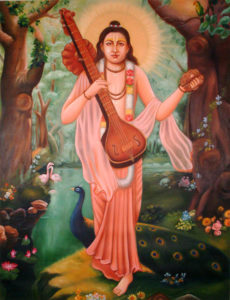
I had mentioned Sangita Makarand in the passing earlier; an ancient work on classical music penned by Narada. For those of you who don’t know about Narada (and I can’t think of many), Narada is a Vedic sage, famous in Hindu traditions as a traveling musician and storyteller, who carries news and enlightening wisdom. When I was small, we used to read about Narada Muni both as wise and as mischievous. I recall that when I read Mahabharta and Ramayana as a child, Narada appeared out of nowhere chanting his famous: Na-ra-in, Na-ra-in (God Vishnu).
As far as music is concerned, you would recall that I told you that our most ancient musical instrument Veena was invented by Narada (Please see: ‘Raaga Based Song Of The Day 48‘). Coming back to Sangita Makarand, this work is a rare collection of definitions, descriptions and comments on all the essentials music by other ancient reputed authors from Bharata Muni to Sharangdeva. Its main feature is the treatiment of Raagas; categorizing them as male, female and neuter. The treatise circa 1100 CE is the earliest text where rules similar to the current Hindustani classical music can be found. Narada actually names and classifies the system in its earlier form before the advent of changes as a result of Persian influences.
There have been three distinct stages in Raaga nomenclature:
- Named after Swaras. This stage occurred prior to 2nd Century BC. For example, after Shadaj swara, originated the name of the Raaga called Shadaji.
- Named after different Janas (Tribes or Clans) in different locations. For example Shakatilak Raaga was named after Shaka tribe.
- Named after Janapada or desh or country of their origin. Therefore, Bengal Raaga originated in Bengal.
The idea of giving you above was to tell you, yet another time, about the richest and most ancient musical tradition in the world.
As I mentioned, today’s song is composed in Raag Basant Mukhari, Tal Kaherava.
Raag Basant Mukhari belongs to the Bhairav Thaat. Coming at the heels of Raag Shankara in Bilawal Thaat, let me tell you that Bhairav is one of the names of Lord Shiva especially in his powerful form as a naked ascetic with matted locks and body smeared with ashes. The raag too has some of these masculine and scetic attributes in its form and compositions. That’s exactly like Shankara in description of name only. However, the difference is that though Basant Mukhari it is a Sampurna-Sampurna raag, Rishabh, Dhaivat and Nishad Komal. Rest All Shuddha Swaras; whereas in Bilawal Thaat, all swaras are Shuddha.
Basant Mukhari is performed during the second prahar of the day; ie, 9 AM to Noon. Raag Basant-Mukhari is a sweet melodious form among morning Raagas. It is however difficult to render smoothly.
Other songs composed in Raag Basant Mukhari are: Dekho bijali dole (Tal Tintal; Phir Wohi Dil Laya Hoon), O basanti pawan paagal (Tal Rupak Tal; Jis Des Mein Ganga Behati Hai), and Wada kar le sajana (Tal Kaherava; Haath Ki Safai).
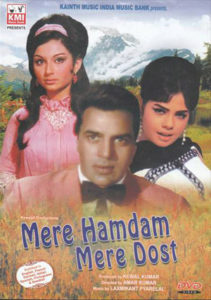 The song Chalo sajana jahan tak ghata chale is from the 1968 Amar Kumar movie Mere Hamdam Mere Dost starring Dharmendra, Sharmila Tagore, Rehman and Mumtaz. The movie had seven songs. All of them were super hits:
The song Chalo sajana jahan tak ghata chale is from the 1968 Amar Kumar movie Mere Hamdam Mere Dost starring Dharmendra, Sharmila Tagore, Rehman and Mumtaz. The movie had seven songs. All of them were super hits:
| 1. | “Chhalka Yeh Jaam” | Mohammad Rafi | 04:50 |
| 2. | “Chalo Sajna Jhahan Tak” | Lata Mangeshkar | 04:48 |
| 3. | “Na Ja Kahin Ab Na Ja” | Mohammad Rafi | 06:19 |
| 4. | “Allah Yeh Ada Kaisi” | Lata Mangeshkar | 07:11 |
| 5. | “Hui Sham Unka Khayal Aa Gaya” | Mohammad Rafi | 04:31 |
| 6. | “Hamen To Ho Gaya Hai Pyar” | Lata Mangeshkar | 04:01 |
| 7. | “Tum Jao Kahin” | Lata Mangeshkar | 05:08 |
As I said, all the songs were penned by Majrooh Sultanpuri and composed by Laxmikant Pyarelal.
Please enjoy in Raag Basant Mukhari, Tal Kaherava: Chalo sajana jahan tak ghata chale…….
Chalo sajanaa jahaa.N tak ghaTaa chale
Lagaakar mujhe gale
Chalo sajanaa jahaa.N tak ghaTaa chale
Su.ndar sapano.n kii hai ma.nzil kadam ke niiche
Fursat kisako itanii, dekhe jo mu.Dake piichhe
Tum chalo ham chale.n, ham chale.n tum chalo
Saavan kii havaa chale
Chalo sajanaa jahaa.N…
Dha.Dakan tumare dilakii, ulajhii hamaarii laT me.n
Tumare tan kii chhaayaa, kaajal banii palak me.n
Ek hai.n do badan, do badan ek hai.n
Aa.Nchal ke tale-tale
Chalo sajanaa jahaa.N…
Patthariilii raaho.n me.n tum sa.ng mai.n jhuum luu.Ngii
Khaaoge jab Thokar, ho.nTho.n se chuum luu.Ngii
Pyaar kaa aaj se, aaj kaa pyaar se
Hamase silasilaa chale
Chalo sajanaa jahaa.N…
We have intended to learn about Raaga based music whilst we entertain ourselves with Raaga based songs. So, lets, once again, take stock of our collective learning so far:
- On the first day we learnt about the Raaga system devised by Pandit Vishnu Narayan Bhatkhande, which is the prevalent system in Hindustani Classical Music and based on ten Thaats.
- On the second day we learnt about Tal or Taal.
- On the third day we learnt about characteristics of Raagas that included Swar, Jati, Thaat, Arohana and Avarohana, Vadi, Samvadi and Pakad.
- On the fourth day, we learnt about Sargam.
- On the fifth day, we learnt about notations used in Indian classical music or simply Swar Lipi.
- On the sixth day, we learnt about the Ras (sentiments) that Raagas evoke.
- On the seventh day, we learnt about various types of Swar: Shuddha, Achal, Vikrut, Komal and Teevra.
- On the eighth day, we learnt the parts of a composition in Indian Classical Music.
- On the ninth day, we learnt the names of some of the popular instruments used in Indian Classical Music.
- On the tenth day, we learnt about the sources of names of Raagas.
- On the eleventh day, we learnt about why Bhairavi is the first raag to be taught to beginners and also why it is the last in a performance.
- On the twelfth day, we learnt about Khammaj Thaat.
- On the thirteenth day, we learnt about Tal Punjabi Theka or Sitarkhani.
- On the fourteenth day, we learnt about Alap.
- On the fifteenth day, we learnt about List of Raagas (Raagmala) in my favourite book: Sri Guru Granth Sahib.
- On the sixteenth day, we learnt about tips for raaga identification.
- On the seventeenth day, we learnt the basics of Gharana system.
- On the eighteenth day, we learnt about Filmi Sangeet.
- On the nineteenth day, we learnt about the commonest Tal in Raagas: Tintal.
- On the twentieth day, we learnt about the Kafi Thaat.
- On the twenty-first day, we learnt a little more in detail about the classification of Raagas.
- On the twenty-second day, we learnt the essential differences between Bhairavi and Bhairav.
- On the twenty-third day, we learnt a little more in detail about the Jati or Jaati of a raaga.
- On the twenty-fourth day, we learnt details of Thaat Bilawal, the most basic thaat in the Bhatkhande’s system of raagas.
- On the twenty-fifth day, we learnt about Tintal.
- On the twenty-sixth day, we learnt in detail about the Raaga – Samay linkage.
- On the twenty-seventh day, we learnt about Lehar.
- On the twenty-eighth day, we learnt about the history of the Hindustani Music.
- On the twenty-ninth day, we learnt about Dhrupad.
- On the thirtieth day, we learnt about Rupaktal that I was introduced to, a few months back, by my friend Anand Desai.
- On the thirty-first day, we learnt about Khayal.
- On the thirty-second day, we learnt about Thumri.
- On the thirty-third day, we learnt about Tappa.
- On the thirty-fourth day, we learnt about Tarana.
- On the thirty-fifth day, we learnt about Tal Dipchandi (Moghali).
- On the thirty-sixth day, we learnt about Tabla.
- On the thirty-seventh day, we learnt about Kirtan.
- On the thirty-eighth day, we learnt about Pakhawaj.
- On the thirty-ninth day, we learnt about Hori.
- On the fortieth day, we learnt about Dadra.
- On the forty-first day, we learnt about Kajri.
- On the forty-second day, we learnt about Chaiti.
- On the forty-third day, we learnt about Sarangi.
- On the forty-fourth day, we learnt about Shehnai.
- On the forty-fifth day, we learnt about Sarod.
- On the forty-sixth day, we learnt about Bansuri.
- On the forty-seventh day, we learnt about Ektal and Tanpura.
- On the forty-eighth day, we learnt about Veena.
- On the forty-ninth day, we repeated our learning of Veena with a small excitement added.
- On the fiftieth day, we learnt about Dilruba/Esraj.
- On the fifty-first day, we learnt about Jaltarang.
- On the fifty-second day we learnt about Qawwali.
- On the fifty-third day, we learnt about Sitar.
- On the fifty-fourth day, we learnt about Surbahar.
- On the fifty-fifth day, we learnt about Harmonium.
- On the fifty-sixth day, we learnt about Santoor.
- On the fifty-seventh day, we learnt about Swarmandal.
- On the fifty-eighth day, we learnt about the Shruti Box.
- On the fifty-ninth day, we learnt about Alankar.
- On the sixtieth day, we learnt about singing in Aakaar.
- On the sixty-first day, we learnt about the Classification of Indian Musical Instruments.
- On the sixty-second day, we learnt a little about Carnatic Music.
- On the sixty-third day, we learnt about Natya Shastra.
- On the sixty-fourth day, we learnt about evolution of musical instruments in India down the ages.
- On the sixty-fifth day, we learnt about Riyaaz.
- On the sixty-sixth day, we looked at a list of Raagas in Hindustani Classical Music.
- On the sixty-seventh day, we learnt about the health benefits of raagas.
- On the sixty-eighth day, we learnt a little more comprehensively about the moods and emotions that raagas evoke.
- On the sixty-ninth day, we learnt about a mobile application to help identify raagas.
- On the seventieth day, we learnt about Melakarta Raagas.
- And today, on the seventy-first day, we learnt about Sangita Makarand.
There is much more still to be learnt and enjoyed.
Please stay tuned!
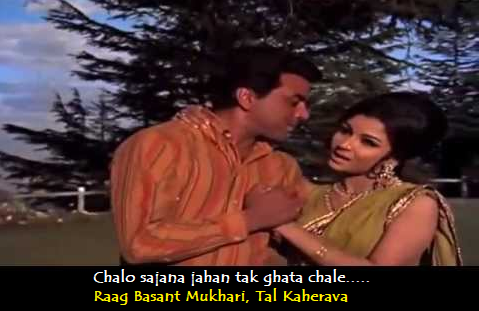
Nice to read about Narada , Veena and Sangita Makarand. All it reveals the rich traditon of music .
Can you tell me, Hui sham unka khayal aa gaya is on which raga?
Thank you, Hitesh ji. To the best of my knowledge, it is not based on any Raag.